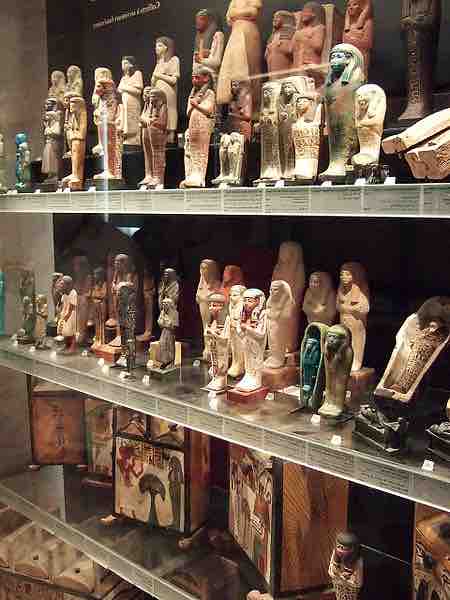Royal funerary practices in the Middle Kingdom remained much the same as in the Old Kingdom, with kings continuing to build pyramids for their burials. Unlike the Old Kingdom, however, Middle Kingdom royal pyramids were not quite as well constructed, and so few of them remain as pyramid structures today. Among the tombs built during this time are Amenemhat I's funerary monument at El-Lisht; Sesostris I's funerary monument; Amenemhat III's pyramid at Hawara, which includes an elaborate labyrinth complex; and Sesostris II's pyramid at Illahun. The construction of pyramids declined toward the end of the Twelfth Dynasty, as instability led to the decline of the Middle Kingdom.
Burial goods continued to be commonplace in tombs. Starting in the First Intermediate period, wooden models became very popular, often depicting everyday activities that the deceased expected to continue doing in the afterlife. The standard coffin was rectangular and brightly painted, often including an offering formula. Unlike the Old Kingdom, objects of daily use were not often included in the tombs; however, they reappeared toward the end of the Middle Kingdom.
Other new objects were introduced toward the end of the Middle Kingdom as well, including the first shabtis (also known as ushabtis) and the first scarabs. Shabtis were funerary figurines placed in tombs of the deceased to help them in the afterlife. Used from the Middle Kingdom until the end of the Ptolemaic Period nearly 2000 years later, most shabtis were of a small size, often covering the floor around a sarcophagus. Exceptional shabtis were of larger size, or produced as a one-of-a-kind master work. They were generally distinguished from other statuettes by being inscribed with the name of the deceased, his titles, and often with spells from the Coffin Texts. Shabtis were created to act as the deceased's servants, performing the manual labor necessary for the plentiful existence of the afterlife.

Shabti figures
Shabti were funerary figurines that were placed in tombs along with the deceased to assist them in the afterlife.
Scarabs were popular amulets believed to be protectors of written products. The scarab was also used as a holder or medium for personal name seals. A figurine of a scarab would be carved out of stone, and then on the smooth stomach of the scarab, the engraving of a seal was made.

A modern imitation of an ancient Egyptian scarab amulet
Scarabs were often included in tombs along with other burial goods as protectors of written products.
Another change in funerary practice during this time had to do with non-royal Egyptians. In contrast to elitist Old Kingdom attitudes towards the gods, the Middle Kingdom experienced an increase in expressions of personal piety and what could be called a democratization of the afterlife. In this worldview, all people possessed a soul and could be welcomed into the company of the gods after death.
In the Old Kingdom, the Pyramid Texts, which contained spells to help the dead reach the afterlife successfully, were only accessible to the elite. During the Middle Kingdom, Egyptians outside of the elite levels of society gained access to this funerary literature and began incorporating it into their own burials. Coffin Texts, as they are called by the scholars, expanded upon the Pyramid Texts, introducing new spells and incorporating slight changes to make them more relatable to the nobility. As seen in the image below, Coffin Texts could appear as paintings or inscriptions on the inside of the coffin. Due to the limited writing surfaces of some of these objects, the spells were often abbreviated, giving rise to long and short versions.
Map of the netherworld from the coffin of Gua, from Deir el-Bersha, Egypt (Twelfth Dynasty, 1985-1795 BCE)
The map inscribed in this coffin comprises part of the Coffin Texts intended to help the deceased navigate through the Duat.
In contrast to the Pyramid Texts, which focus on the celestial realm, the Coffin Texts emphasize the subterranean elements of the afterlife ruled by Osiris in a place called the Duat. People of all classes had access to this afterlife, in which they would be judged by Osiris and his council according to their deeds in life. This realm is described as containing threatening beings, traps, and snares for which the deceased must be prepared. Spells in the Coffin Texts were intended to help the deceased contend with these impediments.